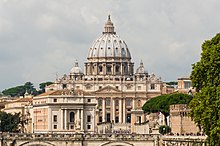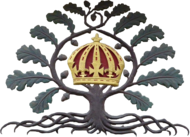|
Traditionalist Catholicism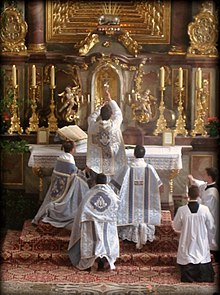
Traditionalist Catholicism is a movement that emphasizes beliefs, practices, customs, traditions, liturgical forms, devotions and presentations of teaching associated with the Catholic Church before the Second Vatican Council (1962–1965).[1][2] Traditionalist Catholics particularly emphasize the Tridentine Mass, the Roman Rite liturgy largely replaced in general use by the post-Second Vatican Council Mass of Paul VI. Many Traditionalist Catholics disliked the liturgical changes that followed the Second Vatican Council, and prefer to continue to practice pre-Second Vatican Council traditions and forms. Some also see present teachings on ecumenism as blurring the distinction between Catholics and other Christians. Traditional Catholicism is often more conservative in its philosophy and worldview, promoting a modest style of dressing and teaching a complementarian view of gender roles.[3] A minority of Traditionalist Catholics reject the current papacy of the Catholic Church and follow positions of sedevacantism, sedeprivationism, or conclavism. As these groups are no longer in full communion with the pope and the Holy See, they are not regarded by Holy See to be members of the Catholic Church, but instead separate religious groupings.[4][2] A distinction is often made between these groups (sometimes called Radical Traditionalists) and Catholics who accept the teachings and authority of the Catholic Church while still preferring older traditions and practices as well as the Tridentine Mass in Latin.[2] HistoryToward the end of the Second Vatican Council, Father Gommar DePauw came into conflict with Cardinal Lawrence Shehan, Archbishop of Baltimore, over the interpretation of the council's teachings, particularly on liturgical matters. In January 1965, DePauw incorporated an organization called the Catholic Traditionalist Movement in New York State, purportedly with the support of Cardinal Francis Spellman, Archbishop of New York.[5] By the late 1960s and early 1970s, conservative Catholics opposed to or uncomfortable with the theological, social and liturgical developments brought about by the Second Vatican Council began to coalesce.[6] In 1973, the Orthodox Roman Catholic Movement (ORCM) was founded by two priests, Francis E. Fenton and Robert McKenna, and set up chapels in many parts of North America to preserve the Tridentine Mass.[6] Priests who participated in this were listed as being on a leave of absence by their bishops, who disapproved of their actions.[6] In 1970, French Archbishop Marcel Lefebvre founded the Society of Saint Pius X (SSPX), made up of priests who would say only the Traditional Latin Mass and who opposed what he saw as excessive liberal influences in the Church after Vatican II. In 1988, Lefebvre and another bishop consecrated four men as bishops without papal permission, resulting in excommunication latae sententiae for all six men directly involved. Some members of the SSPX, unwilling to participate in what they considered schism, left and founded the Priestly Fraternity of Saint Peter (FSSP), which celebrates the Tridentine Mass and is in full communion with the Holy See. In 2009, Pope Benedict XVI lifted the excommunications of the four surviving bishops, but clarified that the society had "no canonical status within the Catholic Church."[7] The Istituto Mater Boni Consilii (IMBC) was founded in 1985. It is a sedeprivationist religious congregation of clergy who were dissatisfied with the SSPX's position on the Pope, i.e., acknowledging John Paul II as pope but disobeying him. Sedeprivationists hold that the current occupant of the papal office is a duly elected pope but lacks the authority and ability to teach or govern unless he recants the changes brought by the Second Vatican Council.[8] Some Catholics took the position of sedevacantism, which teaches Pope John XXIII and his successors are heretics and therefore cannot be considered popes, and that the Catholic Church's sacraments are not valid. One sedevacantist group, the Society of Saint Pius V (SSPV), broke off from the SSPX in 1983, due to liturgical disputes. Another sedevacantist group, the Congregation of Mary Immaculate Queen (CMRI), formed spontaneously among the followers of Francis Schuckardt, but he was later expelled due to scandals and CMRI is now more aligned with other sedevacantist groups. Other groups known as Conclavists have elected their own popes in opposition to the post-Vatican II pontiffs. They are not considered serious claimants except by their very few followers. Different types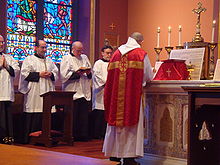 Canonically regular with the Holy SeeSince the Second Vatican Council, several traditionalist organizations have been started with or have subsequently obtained approval from the Catholic Church. These organizations accept the documents of the Second Vatican Council and regard the changes associated with the Council (such as the revision of the Mass) as legitimate, but celebrate the older forms with the approval of the Holy See.
There are also multiple monastic communities, including
See Communities using the Tridentine Mass for a more detailed list. Society of Saint Pius XThe Society of Saint Pius X (SSPX) was founded in 1970, with the authorization of the bishop of Lausanne, Geneva and Fribourg, by Archbishop Marcel Lefebvre. Lefebvre was declared to have incurred automatic excommunication in 1988, after illicit consecrations. In January 2009 the Prefect of the Congregation for Bishops remitted the excommunications the Congregation had declared to have been incurred by the Society's bishops in 1988.[9] More recently, the Vatican has granted SSPX priests the authority to hear confessions and has authorized local ordinaries, in certain circumstances, to grant delegation to SSPX priests to act as the qualified witness required for valid celebration of marriage.[10] The Our Lady of Guadalupe Monastery in Silver City, New Mexico, which is affiliated with the SSPX, is seeking Vatican approval through the society.[11] In 2017, a statement from the Holy See said the SSPX had an irregular canonical status "for the time being".[12] SedeprivationistsSedeprivationists hold that the current occupant of the papal office is a duly elected pope but lacks the authority and ability to teach or govern unless he recants the changes brought by the Second Vatican Council. Sedeprivationists teach that the popes from Pope John XXIII onward fall into this category.[8] Sedeprivationism is currently endorsed by two groups:
SedevacantistsSedevacantists hold that the Vatican II popes have forfeited their position through their acceptance of heretical teachings connected with the Second Vatican Council and consequently there is at present no true pope.[13] They conclude, on the basis of their rejection of the revised Mass rite and of certain aspects of postconciliar Church teaching as false, that the popes involved are also false.[14] This is a minority position among traditionalist Catholics[13][15] and a highly divisive one,[14][15] so that many who hold it prefer to say nothing of their view,[14] while other sedevacantists have accepted episcopal ordination from sources such as Archbishop Pierre Martin Ngô Đình Thục.[15] The terms sedevacantist and sedevacantism derive from the Latin phrase sede vacante ("while the chair/see [of Saint Peter] is vacant").[13] Sedevacantist groups include:
ConclavistsConclavism is the belief and practice of some who, claiming that all recent occupants of the papal see are not true popes, elect someone else and propose him as the true pope to whom the allegiance of Catholics is due. Positions
Pope Benedict XVI contrasted the "hermeneutic of discontinuity and rupture" that some apply to the Council (an interpretation adopted both by certain traditionalists and by certain "progressives")[18] with the "hermeneutic of reform, as it was presented first by Pope John XXIII in his Speech inaugurating the Council on 11 October 1962 and later by Pope Paul VI in his Discourse for the Council's conclusion on 7 December 1965."[19] He made a similar point in a speech to the bishops of Chile in 1988, when he was still Cardinal Joseph Ratzinger:
Responding to a comment that some consider tradition in a rigid way, Pope Francis remarked in 2016, "there's a traditionalism that is a rigid fundamentalism; this is not good. Fidelity on the other hand implies growth. In transmitting the deposit of faith from one epoch to another, tradition grows and consolidates itself with the passing of time, as St Vincent of Lérins said [...] 'The dogma of the Christian religion too must follow these laws. It progresses, consolidates itself with the years, developing itself with time, deepening itself with age'."[21] Radical Traditionalists' assessment of Vatican IIRadical Traditionalists' claims that substantive changes have taken place in Catholic teaching and practice since the Council often crystallize around the following specific alleged examples:
Criticism of the Radical Traditionalists' positionsThose who in response to these criticisms by certain traditionalists defend the decisions of the Second Vatican Council and the subsequent changes made by the Holy See make the following counterclaims:
ReceptionIntegrism is traditionalist Catholicism that integrates social and political contexts. Kay Chadwick described Catholic integrism as a holding "anti-Masonic, anti-liberal and anti-Communist" political objectives. She also noted its alignment with the right-wing press and an annual Parisian Joan of Arc procession with participation by both integrists and National Front supporters. A Tridentine Mass was celebrated before the annual National Front party meeting. Lefebvre was fined in France for "racial defamation" and "incitement to racial hatred" for proposing the removal of immigrants – particularly Muslims – from Europe. Lefebvre also supported Latin American dictatorships, Charles Maurras, Philippe Pétain, and the continued occupation of French Algeria.[29] The Southern Poverty Law Center (SPLC) used the term radical traditionalist Catholics to refer to those who "may make up the largest single group of serious anti-Semites in America, subscribe to an ideology that is rejected by the Vatican and some 70 million mainstream American Catholics. Many of their leaders have been condemned and even excommunicated by the official church."[2] The SPLC claims that adherents of radical traditional Catholicism "routinely pillory Jews as 'the perpetual enemy of Christ'",[2][30] reject the ecumenical efforts of the Vatican, and sometimes assert that all recent Popes are illegitimate.[2] The SPLC says that adherents are "incensed by the liberalizing reforms" of the Second Vatican Council (1962–1965) which condemned hatred for Jewish people and "rejected the accusation that Jews are collectively responsible for deicide in the form of the crucifixion of Christ"[2] and that "Radical traditional Catholics" also embrace "extremely conservative social ideals with respect to women."[2] The SPLC clarifies: "Radical traditionalists are not the same as Catholics who call themselves 'traditionalists'—people who prefer the old Latin Mass to the mass now typically said in vernacular languages—although the radicals, as well, like their liturgy in Latin."[2] PracticesTraditionalist Catholicism has been described as "a self-conscious revival of the liturgies, practices, and trappings of an earlier time in the Catholic Church" and this manifests in a number of ways.[31] Rite of Mass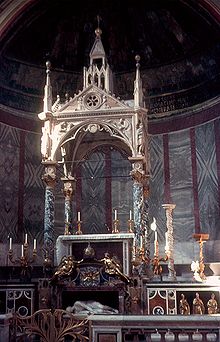 The best-known and most visible sign of Catholic traditionalism is an attachment to the form that the Roman Rite liturgy of the Mass had before the liturgical reform of 1969–1970, in the various editions of the Roman Missal published between 1570 and 1962. This form is generally known as the Tridentine Mass, though traditionalists usually prefer to call it the Traditional Mass. Many refer to it as the Latin Mass, though Latin is the language also of the official text of the post-Vatican II Mass, to which vernacular translations are obliged to conform, and canon law states that "the eucharistic celebration is to be carried out in the Latin language or in another language provided that the liturgical texts have been legitimately approved."[32] In his 2007 motu proprio Summorum Pontificum Pope Benedict XVI relaxed the regulations on use of the 1962 Missal, designating it "an" extraordinary form of the Roman Rite, as opposed to "the" ordinary or normal form, as revised successively by Pope Paul VI and Pope John Paul II.[33][34] The Pope ruled that priests of the Latin Church can freely choose between the 1962 Roman Missal and the later edition "in Masses celebrated without the people".[35] Such celebrations may be attended by those who spontaneously ask to be allowed.[36] Priests in charge of churches can permit stable groups of laypeople attached to the earlier form to have Mass celebrated for them in that form, provided that the celebrating priest is "qualified to [celebrate] and not juridically impeded".[37] The Society of Saint Pius X welcomed the document, but referred to "difficulties that still remain", including "disputed doctrinal issues" and the notice of excommunication that still affected its bishops.[38] In 2021, Pope Francis promulgated Traditionis custodes, amending and abrogating parts of Summorum Pontificum.[39] Individual and private devotionsSome traditionalist Catholics stress on following customs prevailing immediately before the Second Vatican Council, such as the following:
Clothing and lifestyleTraditional Catholics, with respect to male and female gender roles, often adhere to the doctrine of complementarianism.[50] The standards of clothing among Traditional Catholics, based on instructions given by Pope Pius XI and consequently promoted by the Purity Crusade of Mary Immaculate, is referred to as "Mary-like Modesty", which includes for women, wearing sleeves "extending at least to the elbows" and "skirts reaching below the knees", as well as having a neckline no more than two inches with the rest of the bodice fully covered.[51][52] It is commonplace for women who identify as traditionalist Catholics to wear a head covering (veil) while praying at home and attending celebrations of the Mass.[48] In the Ukrainian Greek Catholic ChurchSince the Second Vatican Council, various Eastern Catholic Churches have removed some practices and emphases that were derived from those of the Latin Church. Opposition to this has been given relatively high publicity with regard to the Ukrainian Greek Catholic Church (UGCC). BackgroundEven before the Second Vatican Council, the Holy See declared it important to guard and preserve whole and entire forever the customs and distinct forms for administering the sacraments in use in the Eastern Catholic Churches (Pope Leo XIII, encyclical Orientalium Dignitas).[53] Leo's successor Pope Pius X said that the priests of the newly created Russian Catholic Church should offer the Divine Liturgy Nec Plus, Nec Minus, Nec Aliter ("No more, No Less, No Different") than priests of the Russian Orthodox Church and the Old Believers.[54][55] In the Ukrainian Greek Catholic Church, liturgical de-latinization began with the 1930s corrections of the liturgical books by Metropolitan Andrey Sheptytsky. According to his biographer Cyril Korolevsky, Metropolitan Andrey opposed use of coercion against those who remained attached to Latin liturgical practices, fearing that any attempt to do so would lead to a Greek Catholic equivalent of the 1666 Schism within the Russian Orthodox Church.[56] De-latinization in the UGCC gained further momentum with the 1964 decree Orientalium Ecclesiarum of the Second Vatican Council) and several subsequent documents. Latinizations were discarded within the Ukrainian diaspora, while among Byzantine Catholics in Western Ukraine, forced into a clandestine existence following the Soviet ban on the UGCC, the latinizations remained, "an important component of their underground practices".[57] In response, some priests, nuns, and candidates for the priesthood found themselves, "forced towards the periphery of the church since 1989 because of their wish to 'keep the tradition'." In some eparchies, particularly those of Ivano-Frankivsk and Ternopil-Zboriv, the bishops would immediately suspend any priest who, "displayed his inclination toward 'traditionalist' practices".[58] Vlad Naumescu reports that an article in the February 2003 issue of Patriayarkhat, the official journal of the Ukrainian Greek Catholic Church, written by a student of the Ukrainian Catholic University, which since its 1994 foundation has been, "the strongest progressive voice within the Church". The article named priests and parishes in every eparchy in Ukraine as being involved in "a well-organized movement" and who described themselves as "traditionalists". According to the article, they constituted "a parallel structure" with connections with the Society of St. Pius X and with a charismatic leader in Fr. Basil Kovpak, the Pastor of St. Peter and Paul's Church in the suburb of Lviv-Riasne.[59] According to Vlad Naumescu, "Religious life in a traditionalist parish followed the model of the 'underground church.' Devotions were more intense, with each priest promoting his parish as a 'place of pilgrimage' for the neighboring areas, thus drawing larger crowds on Sunday than his local parish could provide. On Sundays and feast days, religious services took place three times a day (in Riasne), and the Sunday liturgy lasted for two and a half to three hours. The main religious celebrations took place outside the church in the middle of the neighborhood, and on every occasion traditionalists organized long processions through the entire locality. The community was strongly united by its common opponent, re-enacting the model of the 'defender of faith' common to times of repression. This model, which presupposes clear-cut attitudes and a firm moral stance, mobilized the community and reproduced the former determination of the 'underground' believers."[60] Priestly Society of Saint JosaphatThe Priestly Society of Saint Josaphat (SSJK), which operates a seminary, Basilian convent, and numerous parishes, receives priestly orders from the bishops of the SSPX. Its superior, Father Basil Kovpak, has accused the UGCC hierarchy of using intense psychological pressure against priests who are reluctant or unwilling to de-Latinise. In 2003, Cardinal Liubomyr Huzar, Major Archbishops of Kyiv-Galicia, excommunicated Father Kovpak, but this act was later declared null and void by the Roman Rota due to lack of canonical form. On 22 November 2006, Bishop Richard Williamson, who was then a member of the Society of St. Pius X (SSPX), ordained two priests and seven deacons in Warsaw, Poland, for the SSJK. Fr. John Jenkins, an SSPX priest who was present, later remarked, "We were all very edified by their piety, and I myself was astonished by the resemblance of the atmosphere amongst the seminarians with that which I knew in the seminary – this in spite of the difference of language, nationality and even rite."[61] Archeparch Ihor Vozniak of Lviv, the Archeparchy in which the PSSJ is most active, denounced the ordinations as a "criminal act", and condemned Fr. Kovpak's participation in the ceremony. He stressed that the two priests whom Bishop Williamson had ordained would not receive faculties within the Archeparchy.[62] Officials of the Lviv archdiocese said that Kovpak could face excommunication, and that "'he deceives the church by declaring that he is a Greek (Byzantine) Catholic priest,' while supporting a group [SSPX] that uses the old Latin liturgy exclusively, eschewing the Byzantine tradition, and does not maintain allegiance to the Holy See."[63] Father Kovpak's excommunication process was restarted by the hierarchy of the Ukrainian Greek Catholic Church and was confirmed by the Congregation for the Doctrine of the Faith on 23 November 2007.[64] Sedevacantism and Conclavism in the Ukrainian Greek Catholic ChurchIn March 2008 a group of Basilian priests in Pidhirtsi, Ukraine, announced that four of them had been consecrated as bishops in order to save the Ukrainian Greek Catholic Church (UGCC) from heresy and apostasy and in August 2009, they announced the formation of the Ukrainian Orthodox Greek Catholic Church.[65] Having elected Czech Basilian priest Fr. Anthony Elias Dohnal as "Patriarch Elijah", they declared that the Holy See was vacant, establishing the Ukrainian Orthodox Greek Catholic Church (UOGCC).[66][67] The group was promptly excommunicated by the UGCC,[68] an act that was later confirmed by the Apostolic Signatura[69] and the Congregation for the Doctrine of Faith.[70] The UOGCC later "elected" a new Pope, Archbishop Carlo Maria Viganò the former Apostolic Nuncio to the United States, in October 2019. Whether Viganò accepted this "election" is unclear.[71] There have been allegations in both The New York Times and the Lviv-based newspaper Expres that the church leadership is linked to the Russian intelligence services.[72] Relations with the Holy SeeThe Holy See recognises as fully legitimate the preference that many Catholics have for the earlier forms of worship. This was stated in Pope John Paul II's 1988 apostolic letter Ecclesia Dei and Pope Benedict XVI's 2007 motu proprio Summorum Pontificum. The Holy See does not extend its approval to those who oppose the present-day Church leadership, which is reiterated in Traditionis Custodes.[73] Ecclesia Dei CommissionThe Pontifical Commission Ecclesia Dei was founded in July 1988 in the wake of John Paul II's apostolic letter Ecclesia Dei. Benedict XVI was a member of the Commission during his tenure as Cardinal Prefect of the Congregation for the Doctrine of the Faith. Speaking on 16 May 2007 to the Fifth General Conference of the Bishops of Latin America and the Caribbean, Cardinal Castrillón, the current head of the Commission, said his department had been founded for the care of those "traditionalist Catholics" who, while discontented with the liturgical reform of the Second Vatican Council, had broken with Archbishop Marcel Lefebvre "because they disagreed with his schismatic action in ordaining Bishops without the required papal mandate". He added that at present the Commission's activity is not limited to the service of those Catholics, nor to "the efforts undertaken to end the regrettable schismatic situation and secure the return of those brethren belonging to the Fraternity of Saint Pius X to full communion." It extends also, he said, to "satisfying the just aspirations of people, unrelated to the two aforementioned groups, who, because of their specific sensitiveness, wish to keep alive the earlier Latin liturgy in the celebration of the Eucharist and the other sacraments."[74] In 2019, Pope Francis suppressed this commission and transferred its responsibilities directly to the Congregation for the Doctrine of the Faith.[75] Validity of holy ordersThe conferring of holy orders may be valid but illicit.[76] The Catholic Church considers the orders of traditionalist clergy who are in good standing with the Holy See, such as the clergy of the Priestly Fraternity of Saint Peter or the Institute of Christ the King Sovereign Priest, to be both valid and licit. It sees as valid but illicit the orders of the bishops and priests of the Society of Saint Pius X, and accordingly considers them to be forbidden by law to exercise priestly offices, but still technically priests.[77] The Holy See declared devoid of canonical effect the consecration ceremony conducted by Archbishop Pierre Martin Ngô Đình Thục for the Carmelite Order of the Holy Face group on December 31,1975, while expressly refraining from pronouncing on its validity. It made the same statement with regard also to any later ordinations that those bishops might confer, saying that:
DemographicsIn 2005, Catholic World News reported that "the Vatican" estimated the number of those served by the Fraternity of St Peter, the Society of St Pius X and similar groups at "close to 1 million".[79] List of groupsThis is a list of notable traditionalist Catholic groups. Some are in full communion with the Holy See; some have irregular status according to doctrines and disciplines of the Catholic Church. As of 2023, largest priestly communities described as traditionalist are Society of Saint Pius X (SSPX) with 707 priests, Priestly Fraternity of Saint Peter (FSSP) with 368 priests, Institute of Christ the King Sovereign Priest (ICKSP) with 147 priests and Institute of the Good Shepherd (IBP) with 61 priests. Canonically regular traditionalist groups
Canonically irregular traditionalist groups
Sedevacantist groupsSedeprivationist groupsConclavist groupsSee alsoDoctrinal and liturgical issues
Comparable phenomena in other churches
Other
References
Further reading
|
